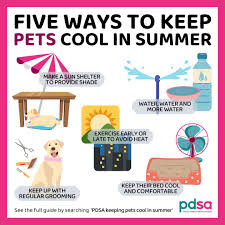Five ways to keep your pets cool when the weather’s hot

Five ways to keep your pets cool when the weather’s hot
When summer arrives in the UK, it seems to appear suddenly. One day we can be wrapped up cosy winter woollies – the next we are panic buying fans and ice lollies.
Any sudden and extreme change in temperature can be dangerous. Every year, people perish as a result of heat-related illness. Weather agencies increasingly release advance alerts of predicted severe weather, including high temperatures, to allow time to prepare for the change.
Extreme temperatures aren’t just a threat to human health, though; they are also a problem for our pets. Human health alerts should also help us to prepare our pets and their environment for extreme weather events, including heatwaves.
Because of global climate changes, it is likely that heatwaves will continue to increase in frequency, length and severity. So owners must become more aware of how to protect pets. Every year, dogs die from being left in hot cars but there are many other risks to pets’ health and welfare. During a heatwave, when the weather changes dramatically, our pets aren’t able to acclimatise to the higher temperatures.
Here are five ways to help keep your pets cool and safe during a heatwave.
1. Travel with care
Dogs in hot cars are at serious risk. Cars can heat up rapidly, even with opened windows. This can be a problem when parked, but our pets can also be at risk of heat exposure while travelling.
Avoid leaving your pet unattended in a closed vehicle without suitable ventilation. Air conditioning is useful – and some modern vehicles have it as an option even while stationery – but don’t leave your pet alone: air conditioning can fail. Opening windows or using air conditioning while travelling is important but do ensure the cool air can flow to where your pet is, especially if they are in the rear of the vehicle.
If stuck in traffic, the air recirculation option in the vehicle can help to maintain a cool temperature inside, while limiting traffic fumes.
Remember: if in doubt, don’t go out.
2. Exercise with caution
Exercising your pet during a heatwave can be fatal.
Unlike humans (and horses) who manage body temperature by sweating, dogs have limited ability to cool themselves. They rely on panting, which can mean that dogs are unable to cool down efficiently while exercising in hot, humid conditions.
Pets at particular risk of suffering from heat exposure include flat-faced animals such as Persian cats, pugs and bulldogs. Unfit, overweight, very young or very old pets and breeds with thick coats also need protection and careful attention in high temperatures.
During a heatwave, walk your dog at cooler times of the day. Make sure routes are shaded and that your pet has access to water. In extreme conditions, you could forego walks entirely and exercise your pet by playing or training inside, if temperatures allow.
Finally, don’t forget that ground surfaces can become dangerously hot in high temperatures and can cause serious burns to paws.
Remember: no dog has ever died from missing a walk but plenty have died from being exercised in heat.
3. Water and shade
Pets need access to cooler, shaded areas and fresh, clean drinking water at all times.
Animals drink more fluid on hot days so, to keep them hydrated, you can add extra water to their meals. Ice cubes added to drinking water can help keep it cool. For working dogs, dehydration is a major heatstroke risk factor so suitable electrolyte solutions can help keep them hydrated.
Small pets such as rabbits, guinea pigs and birds housed in hutches or small cages, which can heat up quickly, are especially vulnerable in high temperatures. Avoid direct exposure to the sun and move the cage to a shaded areas.
Ideally, offer pets choice about how to manage themselves in the heat by giving them access to different areas of the house or garden with shade and ventilation. Dogs might enjoy supervised access to paddling pools. Put cooling mats down in pet resting areas and create air flow by opening windows and setting up fans.
Remember: whether you have an indoor or outdoor pet, they are at risk of heat exposure if they are unable to find adequate shade, water and ventilation.
4. Know the signs
Spotting signs that your pet is suffering from excessive heat exposure is critical so that you can take immediate action.
A subtle change in behaviour, such as restlessness, slowed movement or unwillingness to continue exercising might be the first sign. They may begin to pant and, in dogs especially, look out for the end of their tongue expanding to a wide spatula shape. Pets may be lethargic, have glassy eyes, laboured breathing and unsteady gait – and drool. Affected pets might vomit or have diarrhoea. As the condition progresses, they may have seizures or even collapse.
Remember: heat exposure can be fatal so early recognition and intervention is critical.
5. Emergency action
In 2022, one in four dogs presented to emergency vets with heat-related illness died. So, if your pet shows signs of heat exposure, immediate action is critical.
Begin by pouring cold water all over them. Immersing them in cold water can also help. If the animal is unconscious, ensure you keep their head above water and keep their airway clear.
Avoid covering them in wet towels or cloths, which can add heat, but instead stand or lay them on a cold, wet towel. Continue wetting the pet with cool water and, where possible, fan them. Hold ice packs (or bags of frozen food) between your pet’s inner thighs too.
Offer small drinks of cool water, but do not allow the pet to drink excessively or force them to drink.
Finally, take your pet to the vet in an already cooled vehicle, ideally continuing the cooling measures during the journey.




